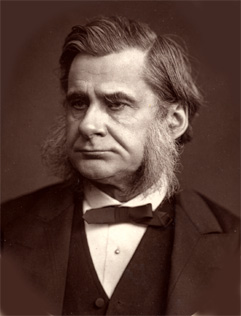
I’ve been discussing Thomas Henry Huxley’s attitude toward and use of William Paley’s Natural Theology (1803). So far, I’ve noted (in part 1 and part 2) that Huxley apparently came to Paley earlier, and stayed with him longer, than Darwin; that in the 1880s Huxley repeatedly invoked a passage from the twenty-third chapter of Natural Theology as endorsing the idea that what he calls “the wider teleology” is compatible with evolution because (as I put it) the fact of design, for Paley, isn’t committed to any particular account of how the design is effected; and that Huxley even went so far as to claim that Paley thereby “proleptically [i.e., in advance] accepted the modern doctrine of Evolution.” Before I say a little about the last of these claims, I want to take a moment to ask: why Paley? Why did Huxley (above) choose Paley (of all people) to make the point?
Consider, after all, that Paley was neither the first nor the last writer to suggest that God can accomplish his purposes in the world—including design—through natural processes. In Summa Theologica (1265–1274), for example, Aquinas refers to “certain intermediaries of God’s providence” which perform their roles “by reason of the abundance of His goodness; so that the dignity of causality is imparted even to creatures.” And in his Astronomy and General Physics Considered with Reference to Natural Theology (1833), William Whewell wrote, “But with regard to the material world, we can at least go so far as this—we can perceive that events are brought about not by insulated interpositions of Divine power, exerted in each particular case, but by the establishment of general laws.” (The latter passage, of course, serves as the first epigraph to Darwin’s Origin!)
The answer is not far to seek. Paley was someone that Huxley’s audience would have heard of, and respected, and even regarded as authoritative on the topic of teleology. (He was especially influential at his alma mater Cambridge University, where he taught for a while, and where his books influenced subsequent generations of undergraduates, although Natural Theology wasn’t often used as a textbook there.) Well before the 1880s, Huxley already was citing Paley as the archteleologist. In 1864, he wrote a response to Albert von Kölliker’s Über die Darwin’sche Schöpfungstheorie [On Darwin’s Theory of Creation] (1864), which described Darwin as a teleologist “in the fullest sense of the word.” Huxley retorted,
It is singular how differently one and the same book will impress different minds. That which struck the present writer most forcibly on his first perusal of the ‘Origin of Species’ was the conviction that Teleology, as commonly understood, had received its deathblow at Mr. Darwin’s hands. For the teleological argument runs thus: an organ or organism (A) is precisely fitted to perform a function or purpose (B); therefore it was specially constructed to perform that function. In Paley's famous illustration, the adaptation of all the parts of the watch to the function, or purpose, of showing the time, is held to be evidence that the watch was specially contrived to that end; on the ground, that the only cause we know of, competent to produce such an effect as a watch which shall keep time, is a contriving intelligence adapting the means directly to that end.
Here Huxley gives a schematic version of the teleological argument followed immediately by a famous illustration of it to be found in Paley: it’s not surprising that he avoided citing a medieval theologian like Aquinas or a contemporary philosopher like Whewell and instead preferred a famous scholar of the previous generation who, literally, wrote the book on natural theology. Yet it’s also remarkable to see Huxley employing the hedge “as commonly understood,” repeating it again and again, thus tacitly insisting on the idea—developed in the Rede Lecture and the essay on the reception of the Origin—that “a wider teleology” is still possible even in the light of evolution. Absent, however, is the notion that it is Paley himself who shows the way to the wider teleology.
Finally, it’s a stretch for Huxley to say that Paley “proleptically [i.e., in advance] accepted the modern doctrine of Evolution.” It’s anachronistic, of course, since the modern doctrine of evolution wasn’t even on offer in Paley’s day. There were glimmerings of it, and after considering and swiftly rejecting the appeal to brute chance to explain design, he considers a protoevolutionary appeal to chance plus selection:
There is another answer which has the same effect as the resolving of things into chance: ... that the eye, the animal to which it belongs, every other animal, every plant, indeed every organized body which we see, are only so many out of the possible varieties and combinations of being, which the lapse of infinite ages has brought into existence; that the present world is the relict of that variety: millions of other bodily forms and other species having perished, being by the defect of their constitution incapable of preservation, or of continuance by generation.
Alas, Paley’s rejoinder suggests that he failed to take the proposal seriously: “Upon the supposition here stated, we should see unicorns and mermaids, sylphs and centaurs, the fancies of painters, and the fables of poets, realized by examples.” So the closest that can be said along Huxley’s lines, I think, is that Paley proleptically provided a tool by which a teleologist (in Huxley’s sense) is able to reconcile teleology with evolution.

